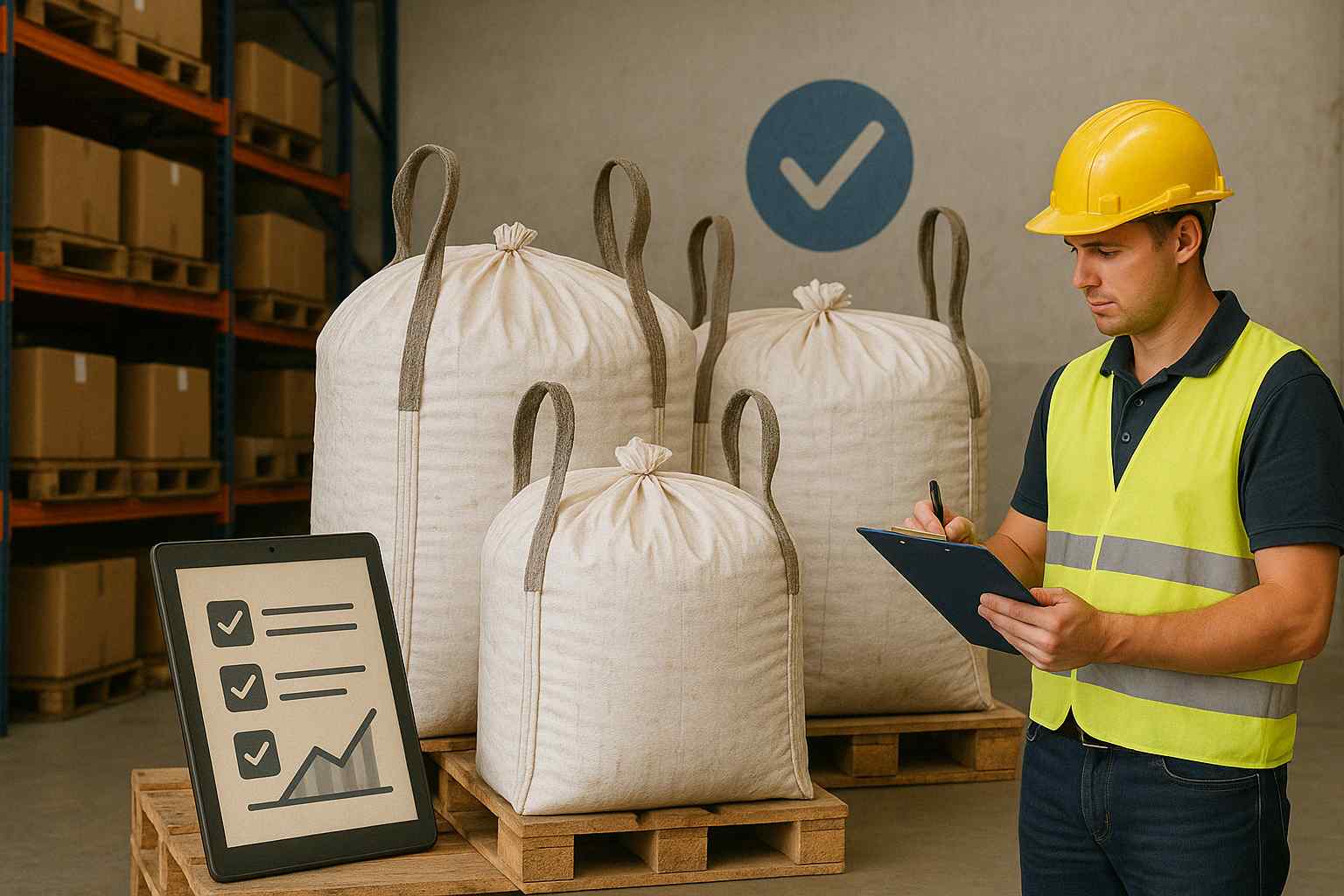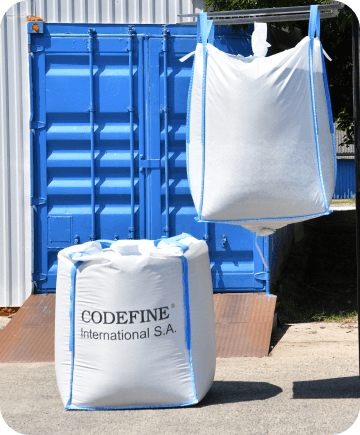Home » Posts Page » Blog » Codefine » Optimizing Inventory Management with Bulk Bags: A Smarter Approach to Efficiency

Thanks to their many benefits, bulk bags make a welcome addition to any warehouse management system. They’re one of the most convenient packaging solutions around if you’re looking to store and organize large quantities of materials. Perfect for finer particles like grains and sand, they can also be used to store far larger items, making them a popular choice across many sectors.
Once filled, bulk bags take on a standardized appearance with uniform dimensions. This makes them particularly useful for inventory management where space is at a premium. Thanks to the consistent dimensions of bulk bags, you can always be confident in how much warehouse space you’ll have available.
Bulk bags also allow for easy retrieval of stored contents. Unlike sacks and drums, which first need to be opened, the open-top design of many bulk bags makes checking inventory a breeze. What’s more, customized discharge options make accessing stored materials incredibly convenient.
Labelling is also straightforward. Bulk bags can be readily printed with everything from branded logos to storage information, further optimizing your inventory management system. Thanks to the inclusion of lifting loops, they’re also easy to handle and compatible with a wide range of warehouse equipment and machinery.
If you’re utilizing warehouse space, streamlining inventory processes is one of the biggest gains in efficiency. Still not convinced about whether or not to streamline your operations? Below are a few of the advantages of refocusing your inventory management processes.
Bulk bags are an obvious choice for warehouse environments, especially where space is at a premium. Once filled, bulk bags can be stacked, meaning even the smallest of warehouse spaces can be used effectively. When empty, their collapsible design means they can be stored discreetly, leaving your square footage free for the storage of more important inventory.
While rigid containers offer similar benefits, they’re not as versatile a solution as bulk bags. Although robust and secure, they’re also comparatively bulky. This limits layout options and storage configurations, making them a suboptimal solution compared to bulk bags.
At first glance, smaller packaging units might seem like a smart choice. While they’re relatively easy to handle and are a cost-effective option, they require more handling steps than larger units like bulk bags. This can complicate operations, generally resulting in longer handling times and increased costs.
With bulk bags, you have a far more efficient packaging solution that involves far fewer stops. Bags can be easily loaded with a range of customized filling options, while unloading is just as simple thanks to tailored discharging features. Meanwhile, lifting loops make it easy to handle filled bulk bags with machinery, making it simple to ready containers for storage or transport.
Looking for simple ways to improve the accuracy of your inventory tracking? With bulk bags, redefining your inventory management systems is straightforward. Bulk bags can be personalized with unique barcodes, allowing for easier identification.
They can also be integrated with radio-frequency identification (RFID) technology, with RFID tags able to store essential information and communicate wirelessly. Perfect if you’re looking for a reliable way to track the movement and location of your inventory within a warehouse. If you’re looking to protect against inventory loss, these tracking solutions are an essential addition to your warehouse operation.
Bulk bags are a solid choice if you’re keen to avoid product waste and protect against contamination. Bulk bags can be enhanced by adding liners when handling sensitive materials, potentially rendering your bulk bags reusable.
What’s more, sealed options can prevent finer particles from escaping during storage or transit, further protecting the bottom line. Additionally, sealed containers can preserve product quality, making them an ideal choice for certain perishables and high-value products.
If you’re thinking about introducing bulk bags to your operation to improve your inventory systems, a few best practices should be observed. Firstly, you’ll need to establish your chosen storage location and determine its properties. How large is the space, and how many bulk bags can it reasonably accommodate? You’ll also want to consider access and loading points, and how these will impact inventory replenishment.
A regimental approach to stacking can also help improve any warehouse management system. By stacking bulk bags correctly, you’ll be making optimal use of vertical space, bringing cost-saving benefits to smaller operations. What’s more, proper stacking will ensure effortless oversight of your remaining inventory and allow for easy replacement.
It’s also a good idea to incorporate RFID tags and barcodes as quickly as possible. These can be used to assign information like quantities, locations, and expiration dates, making them essential for certain industries like the agricultural or food processing sectors.
Warehouse management system.
Bulk bags are a common sight across many industries, with just about every sector employing them for their inventory management benefits. In the food processing arena, bulk bags are regularly used to store and transport raw ingredients, as well as processed products themselves. As well as offering superior protection and helping prevent spoilage, bulk bags provide ready access to stored foodstuffs, making them a must for inventory management.
They’re also central to the agricultural sector. Used to store everything from animal feed to fertilizer, bulk bags are a convenient option for this industry. Their stackable nature makes them a good selection when space is at a premium, allowing smaller farms and warehouses to maximize their storage capacity. They’re also easy to handle by machinery, making it straightforward to access and add to containers while reducing the need for manual labor.
The chemical sector is another frequent adopter of bulk bags. When customized with sufficient labeling containing information about content specifics and expiration dates, they can significantly aid with inventory management. Likewise, different discharger options can help make unloading easier, while protecting against spillage and inventory loss.
Construction companies also regularly use bulk bags. These heavy-duty containers are employed in numerous ways by the construction sector, including everything from the storage of raw materials to the handling of rubble. The hard-wearing design makes them suitable for reuse, while the fact that they can be stacked means they can save space in storage environments and during transportation.
Are you rethinking your current warehouse management system? If your inventory management approaches need refinement, one of the easiest things you can do is introduce bulk bags to your operation. These flexible containers are not only a robust and reliable storage and haulage solution, but they can also help expedite everyday processes, optimize warehouse space, and make it far simpler to stay on top of your inventory.
Looking for quality bulk bags you can trust? At Codefine, you’ll find premium bulk bags at affordable prices. Are you searching for other packaging solutions? Explore our entire product range online today or get in touch with the team to discuss your requirements in more detail.
